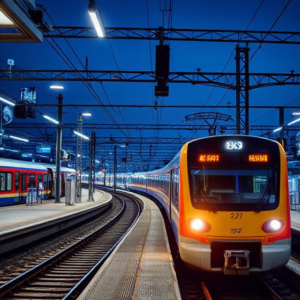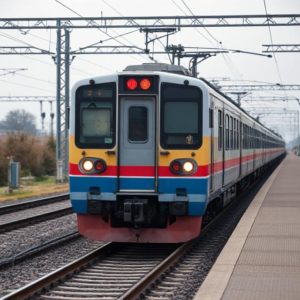Telecommunication networks for railways are systems that allow trains, stations, and control centers to communicate with each other using various technologies. These networks help ensure safe, efficient, and smooth operations by transferring data, voice, and video signals quickly and reliably. Here’s a simple explanation of how they work and why they are important:
1. What is a Telecommunication Network for Railways?
- It’s a network designed to support communication in the railway environment. This includes everything from the train’s onboard systems to the stations, control centers, and even passenger services.
- The goal is to provide fast, secure, and reliable communication to manage train operations, keep passengers informed, and ensure safety.

2. How Do These Networks Work?
Railway telecommunication networks are made up of various types of communication technologies that work together. Here’s a breakdown of the key components:
- Voice Communication Systems:
- Train crew, station staff, and control centers need to communicate quickly and clearly. Voice communication systems (like radios and telephones) are used for this purpose.
- Train drivers can communicate with control centers or other trains, which is essential for safety, coordination, and addressing emergencies.
- Data Communication:
- Trains and control centers need to exchange important information like train positions, speeds, schedules, and technical data (e.g., engine health).
- Fiber Optic Cables: These are used for high-speed data transfer. They can carry huge amounts of data over long distances without losing signal quality. Fiber optics are used for things like signaling systems, monitoring systems, and providing internet to trains.
- Wireless Communication: In some areas, wireless networks (like radio or mobile networks) are used for communication, especially in places where laying cables is difficult.
- Train Control Systems:
- These systems help track train movements and ensure they are safely following their scheduled routes. The communication network transmits real-time information about train positions and speeds between trains and control centers.
- In modern railways, advanced signaling systems like Positive Train Control (PTC) use telecommunication networks to prevent accidents by automatically controlling train speeds and stops.
- Passenger Information Systems:
- Passengers get real-time updates about their train’s status, delays, or changes to schedules through screens in stations or mobile apps. These systems rely on the telecommunication network to send updates.
- Public announcement systems in stations also use telecom networks to broadcast information to passengers.
- Surveillance and Security:
- CCTV cameras at stations and on trains help monitor security. These cameras send live video feeds to control centers through the telecom network, allowing staff to keep an eye on the situation and respond quickly to any issues.
3. Why Are Telecommunication Networks Important for Railways?
- Safety: By allowing real-time communication, these networks help prevent accidents. For example, if there’s an obstruction on the track, the control center can send an alert to nearby trains to stop or slow down.
- Operational Efficiency: With fast data exchange, control centers can adjust schedules, manage train movements, and respond to any disruptions in real-time. This ensures trains run on time and that the network operates smoothly.
- Passenger Satisfaction: Clear communication through passenger information systems helps keep travelers informed. They can know when their train will arrive, if there are any delays, and what platform to go to.
- Maintenance and Monitoring: Railways use telecom networks to monitor the health of the trains, tracks, and other infrastructure. For example, sensors on the train or track can send data to detect issues early, allowing for faster repairs and fewer breakdowns.
4. Key Technologies Used in Railway Telecommunication Networks:
- Fiber Optic Cables: Used for high-speed data transfer over long distances. These cables are important because they don’t lose signal over large distances and can handle a lot of data at once.
- Radio Networks: Trains and stations often use radio waves to communicate over shorter distances, such as for voice communication.
- Wi-Fi Networks: Many modern trains provide Wi-Fi to passengers, allowing them to browse the internet while traveling. This is also part of the telecommunication network.
- Satellite Communication: In remote or hard-to-reach areas, satellite communication is used for connectivity, ensuring that trains can still communicate with control centers even when there’s no traditional network available.
5. Examples of Telecommunication Networks in Railways:
- Indian Railways’ Network: Indian Railways uses a mix of fiber optic cables and satellite communication to provide services for train tracking, signaling, and passenger information.
- European Railways: In Europe, many railways use advanced telecommunication networks to support signaling, train control, and emergency communication. Systems like ETCS (European Train Control System) rely heavily on telecommunication networks for train safety and control.
6. Challenges in Railway Telecommunication Networks:
- Infrastructure Costs: Setting up and maintaining a telecommunication network across large rail networks can be expensive, especially in remote areas or where the railways pass through tunnels or mountains.
- Signal Interference: Communication signals can be interrupted by weather conditions, physical obstacles, or other electronic signals.
- Network Security: Since railway networks often carry critical safety data, they need to be protected against cyberattacks or unauthorized access.
7. Future of Railway Telecommunication Networks:
- 5G Networks: The introduction of 5G technology promises to bring faster, more reliable communication for trains. It will enable smoother, real-time communication for train control and better services for passengers.
- IoT (Internet of Things): Railways will continue to use sensors and IoT devices to collect more data about trains, tracks, and equipment, transmitting it through telecom networks for better decision-making and maintenance.
- Automation: As railways move toward more automated trains, telecommunication networks will be crucial in controlling train movements and ensuring everything operates smoothly without human intervention.
Conclusion:
Telecommunication networks are vital for modern railways. They allow trains, control centers, and stations to stay in constant communication, improving safety, efficiency, and passenger experience. These networks rely on technologies like fiber optics, radio, and satellite communication to keep everything running smoothly and ensure that trains stay on track.
Keywords: Telecommunication networks, Railway











